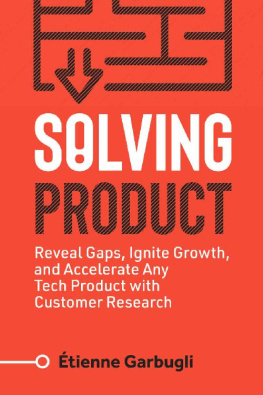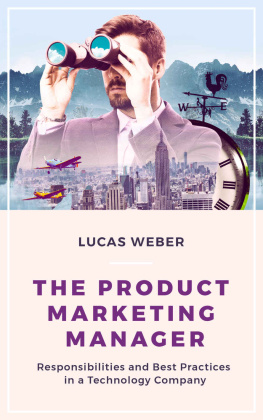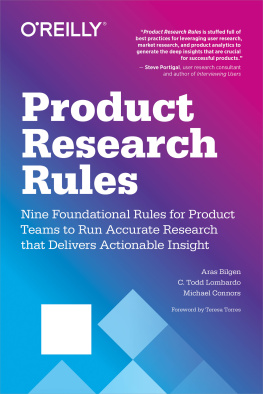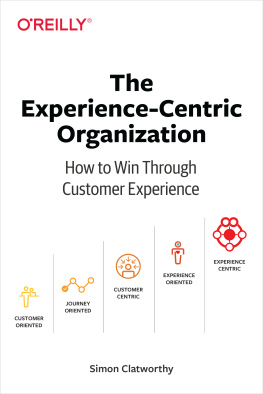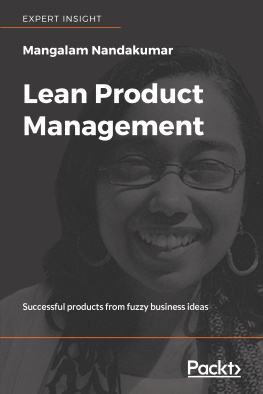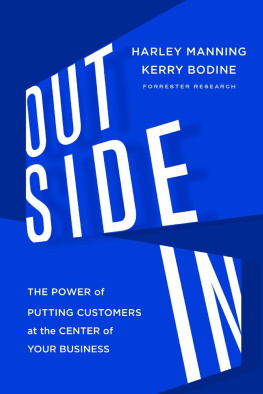Todd Olson - The Product-Led Organization: Drive Growth By Putting Product at the Center of Your Customer Experience
Here you can read online Todd Olson - The Product-Led Organization: Drive Growth By Putting Product at the Center of Your Customer Experience full text of the book (entire story) in english for free. Download pdf and epub, get meaning, cover and reviews about this ebook. year: 2020, publisher: Wiley, genre: Business. Description of the work, (preface) as well as reviews are available. Best literature library LitArk.com created for fans of good reading and offers a wide selection of genres:
Romance novel
Science fiction
Adventure
Detective
Science
History
Home and family
Prose
Art
Politics
Computer
Non-fiction
Religion
Business
Children
Humor
Choose a favorite category and find really read worthwhile books. Enjoy immersion in the world of imagination, feel the emotions of the characters or learn something new for yourself, make an fascinating discovery.

- Book:The Product-Led Organization: Drive Growth By Putting Product at the Center of Your Customer Experience
- Author:
- Publisher:Wiley
- Genre:
- Year:2020
- Rating:5 / 5
- Favourites:Add to favourites
- Your mark:
- 100
- 1
- 2
- 3
- 4
- 5
The Product-Led Organization: Drive Growth By Putting Product at the Center of Your Customer Experience: summary, description and annotation
We offer to read an annotation, description, summary or preface (depends on what the author of the book "The Product-Led Organization: Drive Growth By Putting Product at the Center of Your Customer Experience" wrote himself). If you haven't found the necessary information about the book — write in the comments, we will try to find it.
Todd Olson: author's other books
Who wrote The Product-Led Organization: Drive Growth By Putting Product at the Center of Your Customer Experience? Find out the surname, the name of the author of the book and a list of all author's works by series.
The Product-Led Organization: Drive Growth By Putting Product at the Center of Your Customer Experience — read online for free the complete book (whole text) full work
Below is the text of the book, divided by pages. System saving the place of the last page read, allows you to conveniently read the book "The Product-Led Organization: Drive Growth By Putting Product at the Center of Your Customer Experience" online for free, without having to search again every time where you left off. Put a bookmark, and you can go to the page where you finished reading at any time.
Font size:
Interval:
Bookmark:
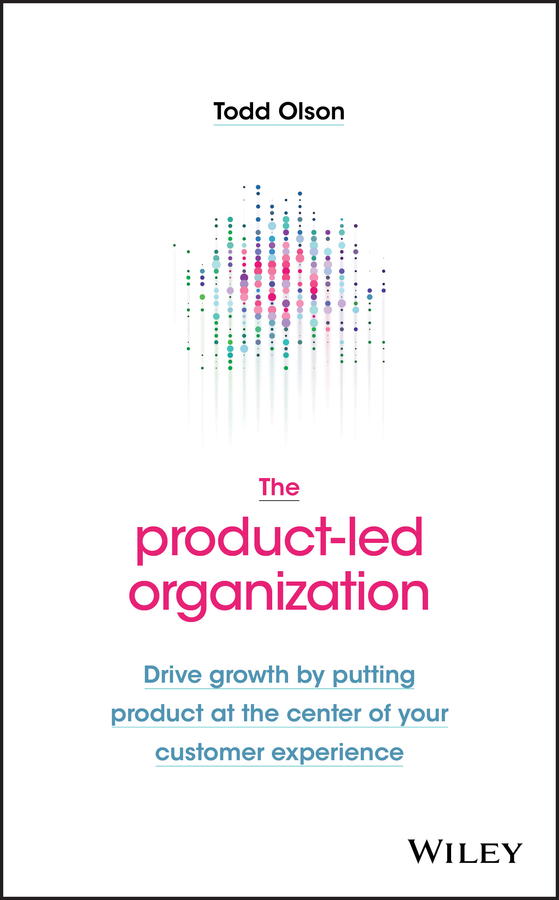
- Chapter 2
- Chapter 1
- Chapter 2
- Chapter 3
- Chapter 4
- Chapter 7
- Chapter 8
- Chapter 9
- Chapter 14
- Chapter 15
- Chapter 16
Todd Olson

Copyright 2021 by Pendo.io, Inc. All rights reserved.
Published by John Wiley & Sons, Inc., Hoboken, New Jersey.
Published simultaneously in Canada.
No part of this publication may be reproduced, stored in a retrieval system, or transmitted in any form or by any means, electronic, mechanical, photocopying, recording, scanning, or otherwise, except as permitted under Section 107 or 108 of the 1976 United States Copyright Act, without either the prior written permission of the Publisher, or authorization through payment of the appropriate per-copy fee to the Copyright Clearance Center, Inc., 222 Rosewood Drive, Danvers, MA 01923, (978) 7508400, fax (978) 6468600, or on the Web at www.copyright.com. Requests to the Publisher for permission should be addressed to the Permissions Department, John Wiley & Sons, Inc., 111 River Street, Hoboken, NJ 07030, (201) 7486011, fax (201) 7486008, or online at http://www.wiley.com/go/permissions.
Limit of Liability/Disclaimer of Warranty: While the publisher and author have used their best efforts in preparing this book, they make no representations or warranties with respect to the accuracy or completeness of the contents of this book and specifically disclaim any implied warranties of merchantability or fitness for a particular purpose. No warranty may be created or extended by sales representatives or written sales materials. The advice and strategies contained herein may not be suitable for your situation. You should consult with a professional where appropriate. Neither the publisher nor author shall be liable for any loss of profit or any other commercial damages, including but not limited to special, incidental, consequential, or other damages.
For general information on our other products and services or for technical support, please contact our Customer Care Department within the United States at (800) 7622974, outside the United States at (317) 5723993 or fax (317) 5724002.
Wiley publishes in a variety of print and electronic formats and by print-on-demand. Some material included with standard print versions of this book may not be included in e-books or in print-on-demand. If this book refers to media such as a CD or DVD that is not included in the version you purchased, you may download this material at http://booksupport.wiley.com. For more information about Wiley products, visit www.wiley.com.
Library of Congress Cataloging-in-Publication Data
Names: Olson, Todd, 1975- author.
Title: The product-led organization : drive growth by putting product at the center of your customer experience / Todd Olson.
Description: Hoboken, New Jersey : John Wiley & Sons, Inc., [2021] | Includes index.
Identifiers: LCCN 2020022830 (print) | LCCN 2020022831 (ebook) | ISBN 9781119660873 (hardback) | ISBN 9781119660910 (adobe pdf) | ISBN 9781119660927 (epub)
Subjects: LCSH: New products. | Product design. | Consumer behavior.
Classification: LCC HF5415.153 .O47 2021 (print) | LCC HF5415.153 (ebook) | DDC 658.5/75dc23
LC record available at https://lccn.loc.gov/2020022830
LC ebook record available at https://lccn.loc.gov/2020022831
Cover Design: Wiley
Cover Image: best_vector/Shutterstock
To my family for all your love and support.
To my team members at Pendo, who inspire and motivate me.
I'm a builder. I've been building and shipping software since I was 14 years old. A lot has changed since then. Like many of you, I remember when shipping software on time with a predictable level of quality was difficult. Projects (often referred to as death marches) were often late, and reports of software that didn't sell well appeared regularly in the news. The Standish Group published a now-infamous study called the Chaos Report, which cited that nearly 84 percent of projects will either fail or go over budget. As if we needed a reminder.
The Chaos Report also said that most features are rarely or never used. OK, so it's not just that we can't build software predictably; we're not even building the right things. Clearly, the Chaos Report was aptly named.
Much has changed, however, since the days of the Chaos Report. Agile development techniques have become the dominant mode of building software. By breaking software development into smaller chunks, Agile methodologies often help us deliver working software more predictably. These techniques and others have significantly improved the success rates of software projectseven in the midst of a global pandemic.
Another challenge in software development was distribution. It's probably hard to imagine that there was a time not all that long ago when we had to ship software on a physical mediumthink CDs (remember those?)or that we had to set up a bunch of infrastructure and manage it ourselves. This was painful and expensive. It's hard enough to build something. Now we have to dedicate people to keeping it running 247. The advent of cloud services, like Amazon Web Services (AWS), the Google Cloud Platform (GCP), and Microsoft Azure have fundamentally changed the game. Developers now develop, test, and then deploy software within minutes. Software can be distributed globally with minimal effort.
So now we can build and distribute software predictably. But what about building the right things in the first place? This is where you may imagine a cue for a record scratch. We still have a long way to go here.
In the spirit of the Chaos Report, my company, Pendo (https://www.pendo.io/), published its own report citing that only 12 percent of software is ever used. Based on our research, we've calculated that some $29.5 billion was invested in features that were never used. And that's just the money invested in public cloud projects; the number would be significantly larger if it also included software built by private companies in the cloud. That almost makes the Standish Group numbers look tame by comparison. While we've made significant progress delivering against deadlines, we're still a bit of a hot mess in deciding what to build in the first place.
After a long career of building software, I eventually found myself in product management. This is where I shifted my focus from the largely met challenge of how to deliver software on time, on budget, and with the right quality, to the largely unmet challenge of building the right things for customers. As I dug in, I saw how little progress had been made.
The Agile community describes the product owner (another name for product manager) role simply as the onsite customer. In other words, the job of product managers is to synthesize inputs from customers, internal stakeholders, and the market to create a roadmap of what to build. Product managers uniquely sit at the intersection of engineering and sales, which gives them a significant amount of influence.
In my professional experience, I've found product people to be some of the most passionate and empathetic people on planet earth. They're wired a bit differently than the average human, possessing a certain compulsionalmost an obsessionto make things and to make them better. Perhaps this is what attracts a lot of people to this role: the general sense that this is a community of people who deeply, passionately give a darn.
Next pageFont size:
Interval:
Bookmark:
Similar books «The Product-Led Organization: Drive Growth By Putting Product at the Center of Your Customer Experience»
Look at similar books to The Product-Led Organization: Drive Growth By Putting Product at the Center of Your Customer Experience. We have selected literature similar in name and meaning in the hope of providing readers with more options to find new, interesting, not yet read works.
Discussion, reviews of the book The Product-Led Organization: Drive Growth By Putting Product at the Center of Your Customer Experience and just readers' own opinions. Leave your comments, write what you think about the work, its meaning or the main characters. Specify what exactly you liked and what you didn't like, and why you think so.


